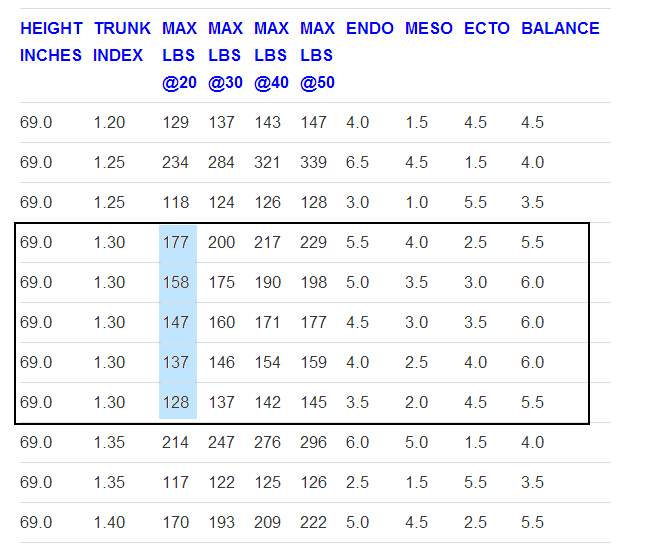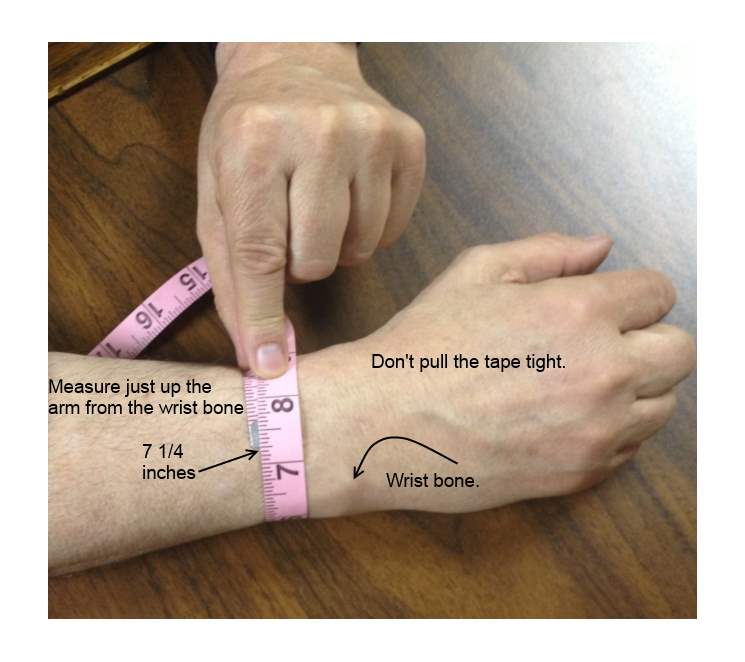USING THE TABLES
Suppose a subject you are somatotyping is a male whose height is 69 inches. Go to the Table of Male Somatotypes (Menu item beneath the website banner). Enter the search command “Control F” (Windows Operating System) Enter “69.0” Always include the decimal if it’s followed by a zero. The chart below shows what you’ll find. The tables are sorted on Height and Trunk Index from lowest to highest. Weight at each age-decade is sorted from heaviest to lightest. Scroll down until you find the Trunk Index. Finally look for the weight pattern that is the best match for the subjects weight information.
In this sample of the Male Somatotype Chart we are focusing on a male subject that is 69 inches and whose Trunk Index is 1.30. As you can see there are five weight patterns from which to choose. This presents a problem that Sheldon didn’t address. Weight is the most variable factor in classifying the human physique. Weight can even change with the time of day a person is weighed. There are several possibilities that can throw off an accurate assessment. It’s also not unusual for people to be 20-30% over their ideal weight.
- Quite often a person will be underweight at the point their body has stopped growing. The early twenties can be a stressful time due to the adjustments of college. Also, it can be a time of intense social activities that distract a person from a regular eating routine.
- A significant number of people in their thirties and forties choose a life style of healthy dieting and regular exercise. These individuals are not going to show the usual weight increase that comes with middle age. Instead they level off at a weight you would normally see in their late twenties.
- There are those who get to a weight that would usually be recorded at a much later decade. This can be due to depression, injuries or other health issues and medications.
One way to deal with these cases is to add one more simple measurement to the somatotyping routine. The measurement that can sort these things out is Wrist Circumference. Wrist size is a fairly accurate indicator of the type of frame a person has. This measurement is expressed as the wrist circumference divided by height. Knowing whether a person has a fragile, average, or large frame can indicate which of the weight patterns is the best fit.
Getting an accurate measure of the wrist is fairly simple, even if you do it yourself. The illustration below shows how this should be done.
The following chart gives typical Wrist Circumference Divided by Height for Males and Females.
When looking at the weight data for each of the somatotypes in a group you will want to focus on the pattern that ranks highest on the somatotype dimension suggested by the wrist measurement. Generally the groups that contain the most weight options are the balanced somatotypes. In those cases there may be as many as three balanced somatotypes framed on either side by a heavy-weight at the top of the group and a light-weight at the bottom of the group.
Light weight subjects that are in their early twenties are the ones that are most likely to need verification based on the wrist measurement. If their wrists are in the ectomorphic range that should explain their low weight. If a light weight person has a wrist diameter indicating a medium frame the focus should be shifted toward patterns where the degree of balance is higher. The heavier somatotypes in a group probably don’t need their wrists measured. The health conscious subjects will usually be at their ideal weight which is usually the average between the age of twenty and thirty.
Somatotyping needs to be connected to an interview process where vital information can be obtained that will clarify the “final” assessment. The word “final” is in quotes to indicate that it would be good to assess a person’s somatotype every five to ten years. This does not mean that the somatotype actually changes but the data may become more representative of the person’s genotype as the their life-style stabilizes. This is why longitudinal studies are preferred.
Sheldon modified his methods many times. The work is not finished. Because there is a strong genetic component to one’s somatotype it makes sense that genetic markers will be quantified that get to the core basis of physical development. The categories that Sheldon defined are an excellent start and will probably fit in with future genetic research. The ideal situation would allow an accurate assessment of any “body” at any age.
For more information about the meaning and value of somatotyping CLICK HERE.




